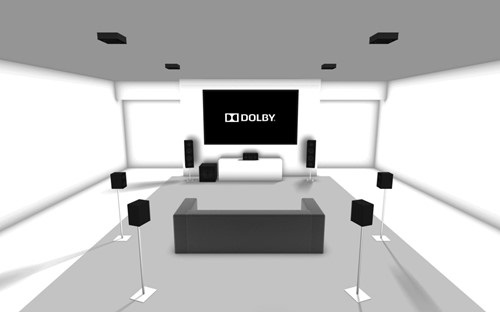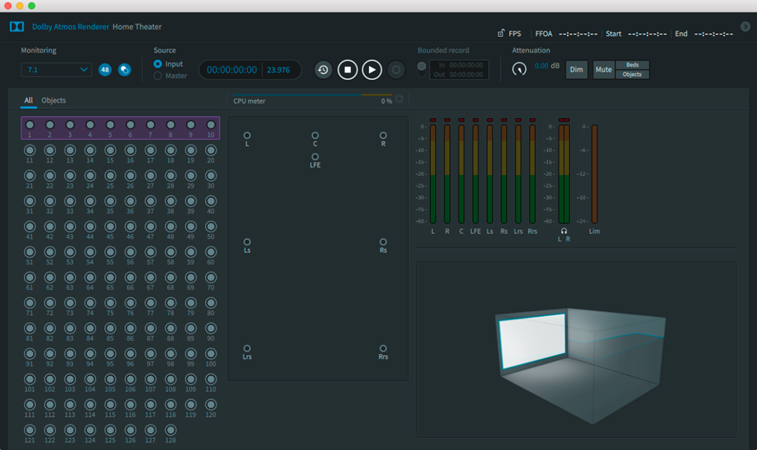
What is Dolby Atmos?
Dolby Atmos is a new immersive audio format that can output up to 64 discrete audio channels. It’s not just a new improved listening experience but also a completely new approach to mixing/mastering immersive surround audio.
When it comes to mixing Dolby Atmos unlike traditional 5.1, 7.1 and similar surround audio configurations, in which the audio is mixed directly to discrete speaker channels, the audio in Dolby Atmos is mixed in X, Y, Z spatial axis by utilizing 3D panners.
Atmos masters can be played back on 2.0, 5.1, 7.1, 9.1.2, a full-blown cinema configuration, a headphone binaural or any other configuration that support Atmos playback without the need for any adjustments.
How are Dolby Atmos mixes made?

To mix in Dolby Atmos, a Dolby Atmos Renderer is required. The software that runs alongside your digital audio workstation and can reside on the same machine or a dedicated computer.
Dolby Atmos Renderer lets you mix, monitor and fold-down Atmos mixes in real time.
When it comes to mixing, the renderer works with audio in the form of beds and objects.
A Bed is a “traditional” mix (up to 7.1.2) that is played back through the according speakers/speaker arrays in your configuration. A bed source would be a dedicated bus in your digital audio workstation.
An Object is a mono or stereo audio source that is positioned fully in 3D in your DAW. In the case of an object a renderer fully takes care of to which speakers the signal should be routed to. An object source would be a mono/stereo track in Pro Tools routed to a dedicated object output. Objects don’t have access to an LFE channel by default.
Atmos renderer has 128 channels available for you to set up your beds and objects.
The renderer can produce a delivery/broadcast ready .atmos masters as well as provide live re-renders in different formats such as 2.0, 5.1, 7.1, 7.1.2, 9.1.2, headphone binaural which can be routed back into your DAW for recording or directly to different sets of speakers if required.
What Dolby Atmos mixing/mastering solutions are there?
-
Dolby Production Suite (in-the-box)
In-The-Box workflows refer to when both the DAW and Atmos Renderer are running on the same computer. In-The-Box workflows might be suffient for somebody working on smaller sessions on more powerful machines like new Mac Pros. There are two main ways of working in-the-box when it comes to Dolby Atmos.
Dolby Audio Bridge
Dolby Audio Bridge is a dedicated audio driver which is selected as your Audio device within Pro Tools. It let’s you interact with the Dolby Atmos rendered via Pro Tools I/O. Dolby audio bridge is the preffered way of working in-the-box for most.
Send & Return Plugins
The Send & Return Plugins allow you to route your beds and object audio from your Pro Tools straight to the renderer and back. This was the original way Dolby Atmos Render would work in in-the-box workflows before the introduction of Dolby Audio Bridge driver. Some people still might prefer this way as though it is a less stable and a bit more clunkier way of working it let’s you use HDX DPS plugins.
-
Dolby Mastering Suite (a dedicated RMU unit)
Dolby Mastering Suite involves using a standalone Rendering and Mastering Unit dedicated solely for the purpose of Atmos playback and rendering. The use of a dedicated RMU increases the stability and performance of the system as all the Atmos processing gets offloaded onto a separate machine. In most configurations an RMU would be a preconfigured Mac Mini with the Dolby Atmos Renderer installed but could be any other Dolby approved computer. Your working Pro Tools machine communicates with the Renderer via either a DANTE audio network or MADI I/O and Dolby Atmos Renderer Remote app. Dolby Mastering Suite supports 24 discrete channel outputs in a speaker array configuration.
-
A Dedicated Cinematic RMU
While mastering suite is suffiecient for Blue-Ray and streaming service delivery and supports up to 24 discrete outuputs. A dedicated cinematic RMU is intended for a full theatric experience and can produce up to 64 discrete outputs depending on your speaker configuration. A dedicated cinematic RMU is not an off the shelf product but instead is a dedicated machine configured by Dolby themselves and lended out to the customer upon them fulfilling the Dolby Atmos certification standards.
How can we help?
Our 30 years of audio experience keeps us on our toes with evolving technologies. The explosion of Atmos streaming content across platforms such as Netflix has meant many studios are looking at how best this technology can be integrated into their facility. Initially, Dolby Atmos was steered towards Film and Television, but now that companies such as Apple are allowing their subscribers to Apple Music enjoy this immersive experience, the technology has made everyone stand up and (literally) listen.
Mediaspec was one of the early adopters of installing Dolby Atmos solutions, and we are here to guide you through the workflow options that would suit your requirements. Quite often this involves taking your room dimensions and producing a document known as a DARDT (Dolby Audio Room Diagram Tool). This enables entry of proposed speaker types, speaker layout dimensions, speaker locations, and speaker and amplifier details with a view to maintaining Dolby specifications. Mediaspec has had success installing varying sizes of Dolby Atmos studios; some of which involving extensive networking workflows. So feel free to give use a call to discuss how Mediaspec can help realise your Dolby Atmos future.
